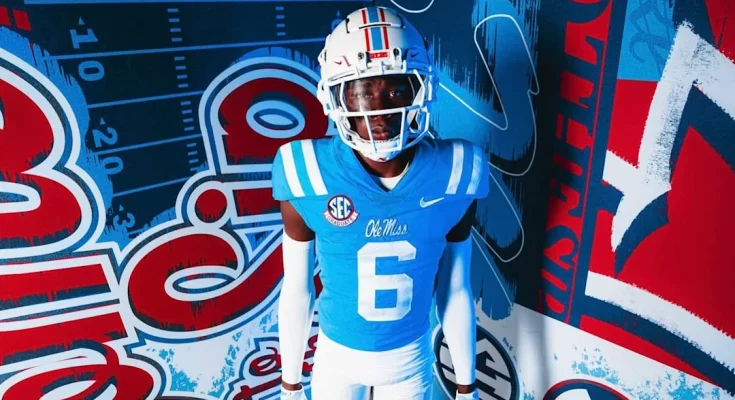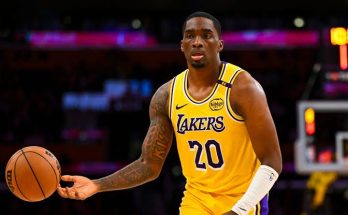The college football recruiting landscape has once again delivered a seismic shockwave, and this time it’s the Kentucky Wildcats who are basking in the afterglow of a stunning victory. In a twist that few saw coming, a prized wide receiver recruit long considered a heavy Ole Miss lean has officially committed to the University of Kentucky. The decision sent shockwaves through SEC circles, leaving fans in Oxford stunned while those in Lexington celebrated what could be a defining moment for the Wildcats’ future.
This is not just another case of a recruit changing his mind at the last minute. This is a story that underscores the volatility, intensity, and strategic maneuvering that defines modern recruiting. The player in question, whose name has been on the radar of scouts and analysts for the past two years, had developed a strong rapport with the Ole Miss coaching staff. He made multiple unofficial visits to the Oxford campus, participated in junior days, and even attended the Rebels’ spring game. At one point, recruiting insiders were convinced it was a done deal. Ole Miss, they said, had done everything right.
But in the world of high-stakes SEC recruiting, nothing is ever truly locked in. Kentucky, a program traditionally overshadowed in football by its basketball counterpart, has quietly been building momentum under head coach Mark Stoops. While Stoops has earned respect for turning Kentucky into a tough, competitive football team, the Wildcats have often struggled to consistently land top-tier offensive playmakers. That perception may have officially changed with this commitment.
For Kentucky, this is more than a symbolic win; it’s a validation of the staff’s strategic focus and recruiting persistence. Over the last few months, Kentucky’s offensive coordinator and wide receivers coach intensified their efforts. They didn’t just show interest—they made the prospect feel like a future star in Lexington. In an era where relationships and fit can outweigh brand names and tradition, the Wildcats sold a vision that ultimately proved too compelling to ignore.
Sources close to the recruitment indicate that Kentucky’s pitch centered on two core promises: immediate impact and offensive spotlight. With a quarterback pipeline that continues to improve and a pass-heavy offensive scheme evolving under Stoops, the coaching staff offered the recruit an opportunity to be a focal point from day one. And unlike at Ole Miss—where a deep receiver room might have forced him to wait his turn—Kentucky presented a clearer path to stardom.
The recruit’s decision also highlights a growing trend in college football: the calculated rebalancing of expectations. Once upon a time, programs like Kentucky were considered fallback options for elite recruits. Now, with the rise of NIL (Name, Image, and Likeness) opportunities, the emergence of dynamic coaching staffs, and the increasing parity in facilities and media exposure, programs like Kentucky are leveling the playing field. The Wildcats’ investment in player development, coupled with aggressive recruiting tactics, is beginning to pay serious dividends.
Reactions from both fanbases were immediate and emotional. Ole Miss supporters expressed disbelief on social media, many questioning how such a seemingly secure recruit could be lured away so late in the game. Rumors of NIL packages and behind-the-scenes developments swirled within minutes of the announcement, though the recruit himself cited “relationships, opportunity, and the vision Coach Stoops shared” as his primary reasons for choosing Kentucky.
In Lexington, the mood couldn’t be more different. This commitment is being heralded as a program-changing moment, with fans celebrating not only the player’s talent but what it represents—a new era of belief. The Wildcats have long been considered a tough out in the SEC East, known for gritty defense and physical play. But the narrative that they can’t attract premier offensive talent may be finally laid to rest.
For Ole Miss head coach Lane Kiffin, the loss is a stinging reminder of the fragility of verbal commitments. While Kiffin’s offensive acumen is unquestioned and the Rebels continue to be a force in the recruiting landscape, this episode will likely prompt a reevaluation of communication strategies and prospect engagement. In the ever-shifting chessboard of recruiting, no lead is ever safe, no matter how strong it may appear.
Analysts are already projecting the kind of impact this wide receiver can have in the SEC. Blessed with blazing speed, excellent route-running ability, and reliable hands, he possesses all the traits needed to become a household name. His high school highlights are filled with jaw-dropping plays—acrobatic catches, breakaway runs, and game-changing moments that showcase his ability to turn the tide of a game single-handedly. At Kentucky, he won’t be buried on the depth chart or pigeonholed into a limited role. The Wildcats made it clear they envision him as a cornerstone for their offense.
This decision may also influence other recruits, particularly those on the fence about choosing between more traditional powers and emerging programs. One elite commitment has a ripple effect—it signals to others that something special is happening. It says, “You don’t have to go to Alabama or Georgia to be a star.” And for Kentucky, that message is pure gold.
The broader implications for the SEC are equally significant. The conference has long been a gauntlet of football dominance, with a select few schools dominating both the standings and the recruiting headlines. But shifts like this show the growing parity in the league. Kentucky is no longer content to play spoiler. They’re aiming to contend. And winning battles like this one is how it starts.
Another element at play is the intangible confidence that comes with a win of this magnitude. For the Kentucky coaching staff, it’s a confirmation that their message is resonating. For the locker room, it’s a sign that the program is growing in stature. And for the fanbase, it’s a moment to believe. When top-tier talent chooses your school over a conference rival with a more decorated history, it creates a cultural shift.
Looking ahead, expectations will undoubtedly rise. This commitment will bring attention, hype, and scrutiny. The pressure to develop the player, feature him in the offense, and continue stacking elite recruiting wins will intensify. But that’s the territory of a program on the rise. Kentucky is no longer a team hoping to make noise. They’re a team that demands to be heard.
The recruit, for his part, expressed excitement and relief. In a statement released shortly after the announcement, he said, “It wasn’t easy. Ole Miss showed me a lot of love and I respect their program a lot. But Kentucky just felt right. I see what they’re building, and I want to be a part of it. They believe in me, and I believe in them.”
Those words, while simple, encapsulate the heart of modern recruiting. It’s about more than just stadium size and win totals. It’s about vision, trust, and opportunity. Kentucky offered all three—and in doing so, they outmaneuvered a formidable SEC rival.
This recruiting win will be dissected for weeks to come. Coaches from across the conference will take note. Media outlets will revisit their class rankings. Fans will dream bigger than ever. But perhaps the most important outcome is this: the belief that Kentucky football can attract, retain, and elevate elite talent has never been stronger.
In the unpredictable, high-stakes world of college football, wins come in many forms. Some are earned on Saturdays in the fall. Others are won in the living rooms of high school stars. This one—snatched from the grip of an SEC rival—might just prove to be one of the most important victories of the Stoops era.



